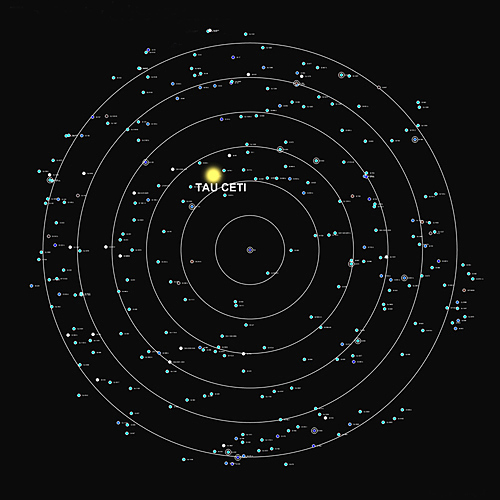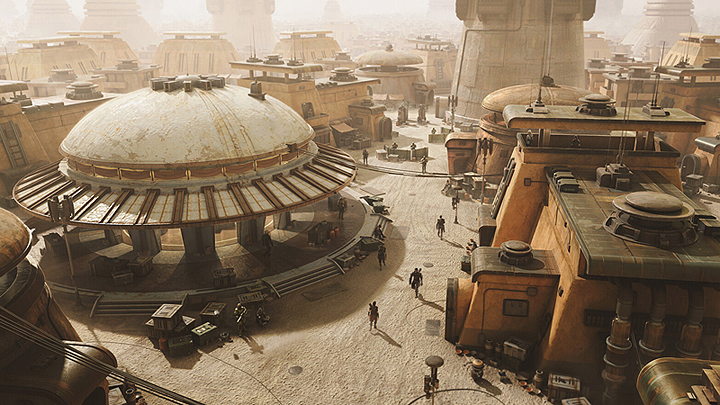
DISTANCE: 11.9 light years from Sol
NEIGHBORING SYSTEMS: Epsilon Eridani 5.5 lys Gliese 876 10 lys 82 Eridani 11.9 lys
TAU CETI is a yellow-orange dwarf with a total of seven planets in orbit. Six of these are rocky worlds that are in close proximity to the host star while the seventh planet is a gas giant which orbits within a vast, cold dust disk at the edge of the system. This debris field contains ten times more cometary and asteroidal material than the Sol system and includes large concentrations of Eridium ore.
GALBRAITH is the fifth planet in this system and has a surface made up primarily of widespread deserts, fertile savannas, and extensive water-filled canyons. There are no major oceans, but five large seas and numerous lakes are scattered sporadically across the terrain. This world has an axial tilt of 35 degrees; possibly due to a large asteroid impact during the early stages of planetary development. This tilt causes distinct seasonal changes and often drastic temperature variations throughout the year. During the first half of the planet’s orbit, the hemisphere inclined towards the star becomes increasingly hot; melting small portions of polar ice which then floods the surrounding areas with mineral-rich tributaries. The region receiving the most direct sunlight becomes nearly uninhabitable with temperatures reaching as high as 65 C. Meanwhile, the hemisphere inclined away from the star becomes bitterly cold. Any snowfall during this time comes shortly after the equinox, although it is generally too dry for long-term accumulation. Temperatures in the more moderate regions average around 40 C in the summer months and around -8 C in the winter months. Slightly more massive than Earth, this planet has a surface gravity of 1.2 Gs. Galbraith also has one large moon named Odessa.
Though the environment here could be considered harsh, many diverse lifeforms have evolved on this world and include a variety of mammals, huge flightless birds, and large crawling arthropods.

The Tau Ceti system was first colonized in 2156 by Frontier Industries; making it the seventh star system to be settled by Humans outside of Sol. As the only colonization mission that was financed almost entirely by company employees, the first settlers here were an extremely self-reliant group of individuals who chose to leave Earth and make a fresh start on a new world. The United Earth Conglomerate declined to provide any subsidized funding towards the project due to their doubts concerning any colony’s long term viability. This was of little concern to these early pioneers as they already sought to distance themselves as much as possible from the influence of the UEC.
Named after Dr. Ian Galbraith, who was credited with its original discovery, the planet Galbraith had a variety of indigenous grains and leafy vegetables which flourished in the more temperate regions, but only for a very short period of time. The Cetians, as the colonists soon came to call themselves, quickly realized that any provisions they managed to gather during the brief harvest season had to last them until the following one. Supplementing their food stores with native fish and wild game became a necessity for survival. Their persistence and determination enabled them to go from simply subsisting in makeshift shelters to actually thriving in a robust community in less than a decade. Although still required to follow the official mandates outlined by the UEC, they were fiercely independent and soon developed their own provisional government with a Colonial Council that was responsible for establishing local bylaws, as well as determining their level of involvement with the other colonized systems.

As some measure of civilization began to develop, Galbraith quickly became a popular destination for those who wished to start over on a world far from the greed and corruption of the UEC. According to the census of 2233, this planet now has a combined population of over 3 million people spread across three urbanized territories. The city of Covenant, which is located in a relatively temperate region off the coast of the Ephemeral Sea, was originally established as both a fishing and farming community. Since then, this port city has grown into a rich and diverse society where nearly all of Galbraith’s interstellar business transactions take place. Drylock Valley, which is situated in the arid desert region of the Tartarus Crater, is a small mining community with an extensive aqueduct system. This crater is over 500 km across and is believed to be the site of the major asteroid impact which caused Galbraith’s extreme axial tilt. And finally, the township of Tusker Ridge, which is located in the vast northern plains, was originally established as a simple outpost for hunting wild game. This thriving community no longer has any need to hunt as they have turned their efforts to raising their own indigenous livestock for food. It has also become one of the busiest centers for local trade on the entire planet.
As the founding corporation in this system, Frontier Industries continued its long-standing commitment to developing its own commercial facilities off-world. This innovative company established a chain of orbital defense satellites to guard the planet against stray meteorites, constructed PILGRIM OUTPOST on the surface of Galbraith’s large moon, Odessa, where they began building their own small fleet of freighters and mining vessels, and instituted a dozen mining operations throughout the asteroid field to extract a variety of valuable resources. In less than thirty years, this corporation had begun exporting large quantities of refined Eridium-D to several of the other colonies. Although the UEC initially considered this system to be of little consequence, Frontier Industries’ rapid economic growth made them a serious competitor with the Epsilon Eridani system which was controlled by the Mining Guild. In response, the UEC began to levy higher taxes on all non-union colonies and tensions towards Earth’s government only grew worse.
Despite this additional hardship, the Cetians maintained their tradition as expert engineers and builders by establishing a second construction facility in orbit around the seventh planet, Tantalus. Determined to avoid any further government interference, the Durre Menthor shipyard was hidden deep within the rings of dust, ice, and asteroids that encircle this large gas giant. Not only did they construct dozens of new freighters and mining vessels for their own operations, but a large percentage of them were sold to a variety of freelance companies as well. During the long conflict with the Zendathu, this system was too remote to be directly affected by any of the major battles, but they began preparing for the possibility by constructing their own private defense fleet. Many of the vessels that were built here came to the aid of the other colonies on numerous occasions to fight this relentless enemy.
In 2195, Frontier Industries combined its financial resources with the Mantell Corporation and the Heimdall Foundry to colonize the 82 Eridani system. This project was such a success that the UEC took notice and, less than a year later, Earth’s corporate empire instituted a new mandate establishing the formal annexation of all secondary colonies within its jurisdiction. This new policy affected other systems as well, but for the Cetians it was the final offense. The Colonial Council made an unprecedented decision and officially declared Galbraith’s independence from both Earth and the UEC. No colony, at that time, had yet dared to attempt a complete separation from the Human homeworld and the UEC had no intensions of allowing “a bunch of uncivilized cowboys” to overstep their bounds. SolCorp’s military forces immediately dispatched three of its battle cruisers to intervene and were prepared to establish martial law by any means necessary. When they arrived in orbit around Galbraith, they found themselves caught between the planetary defense satellites and nearly a dozen Cetian gunships which had been hiding within the rings of Tantalus. A fierce battle began which led to heavy casualties on both sides. In the midst of the conflict, two Centauran battle cruisers and one Cygnian vessel arrived to defend the colonists who had supported them during the Zendathu war. SolCorp had no choice but to concede and withdraw from the system.
From that day forward, many of Earth’s colonies began to question any loyalties they’d once had towards the UEC. After the signing of the “Contract of Sovereignty”, which officially recognized the independence of both Tau Ceti and its sister colonies, Earth’s corporate empire reacted by tightening its hold on all of its remaining systems. This action led to a cascade effect where the UEC found itself losing one system after another as several colonies began to declare their own independence.

In 2209, the Tau Ceti Federation and the colonies in the 82 Eridani system united to form the Commonwealth Alliance with the city of Covenant as its official capital. This alliance not only combined all of their financial resources, but also established a pact to defend and support each other in times of crisis. Since then, they have made a significant effort to explore the mostly uncharted Western regions of space. Their exploratory division has established a successful mining operation in the Kappa Ceti system and has even made contact with other alien races as well.
The Cetian people continue to be fiercely independent and headstrong. They tend to be very pragmatic, yet extremely proud of all that they’ve accomplished. While most enjoy a rather simple life on the rugged world of Galbraith, many of them feel just as comfortable aboard a ship exploring the vast frontier of space.